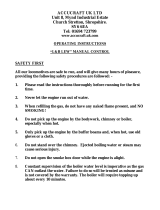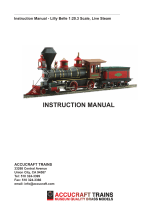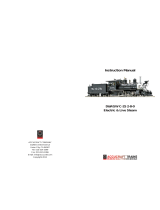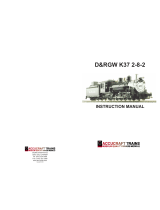Page is loading ...

Instruction Manual - Mogul Live Steam
ACCUCRAFT TRAINS
33268 Central Ave
Union City, CA 94587
Tel: 510 324-3399
Fax: 510 324-3366
E-mail: [email protected]
www.accucraft.com

Instruction Manual - Mogul Live Steam
Page 1
OPERATING INSTRUCTIONS
Baldwin “Mogul” Live Steam
INTRODUCTION:
The Mogul was a small sized, inside frame
locomotive that worked all over North and
South America. These engines were built in
the 1870’s and 1880’s. The Moguls shared
many common parts with the 4-4-0’s of the
same period. The small drivers and wheel
arrangement gave these engines greater pull-
ing power than the 4-4-0’s that were mainly
built to pull short passenger trains of the day.
Our prototype of our model can be seen at
the California State Railroad Museum in
Sacramento, California. It is located on the
second floor of the main building.
SAFETY FIRST:
All our locomotives are safe to run, and will
give many hours of pleasure, providing the fol-
lowing safety procedures are followed:
1. Please read the instructions thoroughly
before running for the first time.
2. Always do a complete refill of gas, oil and
water. Never refill just the gas to prolong
the run.
3. Never let the engine run out of water.
4. When refilling the gas, do not have any
naked flame present, and NO SMOKING!
5. Do not pick up the engine by the body-
work, chimney or boiler, especially when
hot.
6. Only pick up the engine by the buffer
beams and, when hot, use old gloves or a
cloth.
7. Do not stand over the chimney. Ejected
boiling water or steam may cause serious
injury.

Instruction Manual - Mogul Live Steam
Page 2
GENERAL HINTS:
As with all operating machinery, whether
model or full size, wear will occur. In the
model steam locomotive much can be done to
help prolong its life and decrease the amount
of time required in the workshop for servic-
ing.
Keep the engine as clean as possible, and
the motion free from dirt and garden debris.
The valve gear, axles and crank pins should
be oiled sparingly with light oil, e.g. “3-in-1
oil.” Over-oiling attracts dirt and grit, which
will increase wear.
Regularly check that all screws and motion
bolts are firm. Do not over-tighten, as the
strips threads and shears bolts. When fill-
ing the lubricator, always use high tem-
perature superheat steam oil, suitable
for locos fitted with super heaters; this
is available from garden railway product
retailers. FAILURE TO USE THE CORRECT
GRADE OF OIL CAN LEAD TO BLOCKED
STEAM PIPES, AND WILL INVALIDATE
THE GUARANTEE.
When running your engine, avoid excessive
speed and acceleration, both will cause pre-
mature wear in the valve gear. Prototypically,
narrow gauge locomotives ran at a speed of
between 10 and 20 m.p.h, and never should
exceed 25 m.p.h.
END OF RUN:
As previously mentioned, the locomotive will
slow (due to pressure dropping) when the fire
has gone out. Stop at a convenient place
and open the lubricator drain valve. Blow out
tall condensed water and the remaining oil.
Leave the drain valve open and allow all the
remaining steam to blow out. The locomotive
should be allowed to cool. When cool, clean
the engine, check the motion and oil if neces-
sary. The locomotives should always be put
away in a clean condition, as it attracts less
dust and is always ready for the next run (or
to be shown to an admiring friend). It is advis-
able to store the loco where any residual drips
of oil or water do not matter.
BLOCKED GAS JETS:
If the gas jet becomes blocked with particles
of dirt within the gas, the jet will have to be
removed and cleaned. Using a spanner or
pliers carefully undo the pipe union on the
gas control valve. Remove the pipe and jet
holder assembly from the burner. Holding
the jet holder, gently in a vice, unscrew the
jet. To clear, place the jet nozzle against the
inverted gas can nozzle and clear the jet with
a blast of gas. Under no circumstances use
a wire, this will damage the jet hole. Replace
the jet in the holder, ideally using a thread
sealant sparingly on the threads. Ensure it
is tightened up firmly. Replace the assembly
into the burner and re-connect the pipe to the
control valve. Ensure this is done up tightly,
test CAREFULLY with a flame and the gas
“just on,” for gas leaks. Tighten if required.

Instruction Manual - Mogul Live Steam
Page 3
PREPARATION FOR RUNNING:
Always service the engine in the following
order; gas, oil then water.
To fill the gas tank: invert the gas can and
apply the nipple to the gas inlet valve on the
top of the tank turret. It is advisable to support
the loco under the gas tank whilst filling, to
prevent the engine tipping over. You will know
when the tank is full; gas will blow back from
the inlet valve in a strong jet. A small amount
of gas and air will escape during filling, but the
difference between this and when the tank is
full is always clear. Always keep the gas can
valve vertical when filling the gas tank.
To fill the lubricator: as you will read in the
instructions for the “end of the run”, the lubri-
cator should be empty of oil and water with
the valve left in the open position. Now close
the valve and remove the filler cap. Fill-up
the lubricator with steam oil to about a inch
below the top. Leave the filler cap off for the
present, so that any trapped air can escape.
Remember to refit the cap after you have filled
the boiler.
To fill the boiler: remove the filler cap. Fill
the boiler completely- ideally using distilled
water, using the large syringe provided.
When the boiler is full of water, pull out 20
ml. of water using the large syringe. This will
allow space in the top of the boiler for steam
to build. Replace the boiler filler cap. Filler
caps should be firm finger tight. They are
sealed with a trapped “O” ring and, therefore
should not be over-tightened.
LIGHTING UP:
Open the smoke box door; just pull it open by
the door handle. Light your lighter/match etc.,
and gently open the gas control valve until a
gentle hiss is heard in the burner. Apply your
light in to the smoke box and the flame should
‘pop’ down the fire tube and ignite the burner
inside the fire tube. If the gas valve is opened
too much the flame will not pop back; it will
either fail to ignite, will roar in flame out of
the smoke box, or there will be a ball of flame
around the front of the engine, which will then
blow the whole fire out ( after giving the driver
a fright)! When the fire sound has stabilized,
after about 30 seconds the gas can be turned
up until a healthy roar is heard. The smoke
box door may be shut after about two minutes.
Now leave the locomotive to raise steam.

Instruction Manual - Mogul Live Steam
RUNNING:
When the engine has raised about 40 psi, you
are ready to start running. It is advisable to
run the engine in reverse first; it clears the
condensed water from the cylinders best this
way. Before commencing your first run of the
day, it is advisable to put a cloth loosely over
the chimney for a few minutes, as condensed
water will be ejected from the chimney. This
is quite normal; the motion of the engine will
be jerky until all condensate has been ejected.
DO NOT stand over the chimney as ejected
boiling water/steam could cause serious
scalding.
Place the direction lever into the reverse posi-
tion, and then open the main steam valve.
The engine should start to move off in the
reverse direction. When starting from cold it
will be jerky, this is normal, as it has to clear
the condensate from the system. The more
the main steam valve is opened, the faster the
engine will go; our advice is to start slowly and
learn the road with your engine.
After a minute or so, remove the cloth and con-
tinue running. In running it is correct practice
to balance the boiler pressure against the load
being pulled and the track conditions. With
a light load and level track the pressure may
need to be only 25-30 p.s.i. Therefore, turn
the gas control down to keep this pressure.
When running a heavy train with steep gradi-
ents, increase the pressure by turning up the
gas. The ideal running pressure can be learnt
by experience and is one of the pleasures of
running a live steam engine. There is no need
to have the safety valve constantly blowing off
(it is what its name implies – a safety vent for
excess steam pressure). In all our designs,
the gas has been programmed to run out just
before the water, thus it is important not to
refill with gas alone in order to lengthen the
run by a few minutes. When the gas runs out
a complete gas, oil and water service must
be done (remember GOW, also remember
to shut the gas regulator before refilling, and
DO NOT refill with gas near any other live
steam loco). When locomotive slows as the
pressure falls at the end of a run, stop the
engine. Gently open the lubricator valve and
blow out any condensed water. If you intend
to continue running, close the drain when you
see oil coming out of it and carry out a gen-
eral refill. If it is the last run of the day, leave
the lubricator drain valve open and blow the
lubricator completely clean.
Page 4

Instruction Manual - Mogul Live Steam
POSITIONS OF FILLERS AND DRAINS
ETC.:
The cab roof slides back to give access to all
fillers.
The gas tank is in the front nearside corner
of the cab, the gas-filling valve is on the top
of the gas tank turret. The gas control valve
is attached to this turret, and can be operated
through the nearside cab doorway.
The lubricator is in the offside front of the
cab, just forward of the doorway and the
reverse lever. The filler cap has a “T” bar in it
to aid removal. The lubricator drain is directly
beneath the lubricator. To drain, un-screw the
drain valve through about a turn.
The boiler water filler is on top of the steam
turret on the boiler in the middle of the cab.
Undo the knurled cap to fill with water. The
main steam regulator valve is the wheel valve
on the rear of the boiler-filling turret.
The direction control is the lever in the
offside cab door. To operate, pull gently out-
wards and move to the desired direction. The
control is “gated,” and will therefore hold itself
in the full forward or reverse position.
Page 5
/















